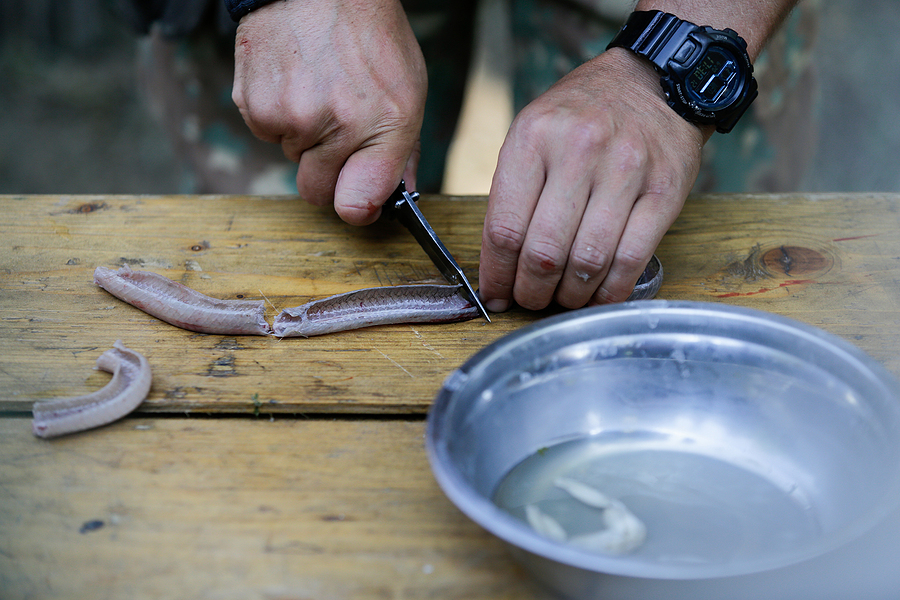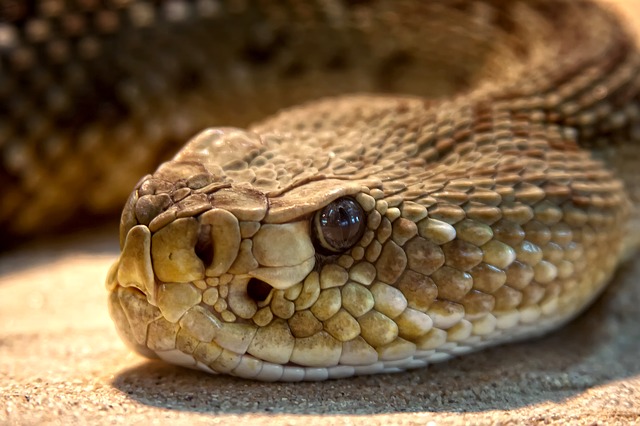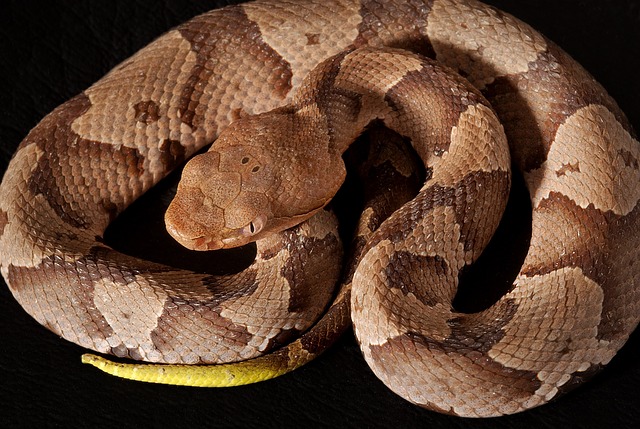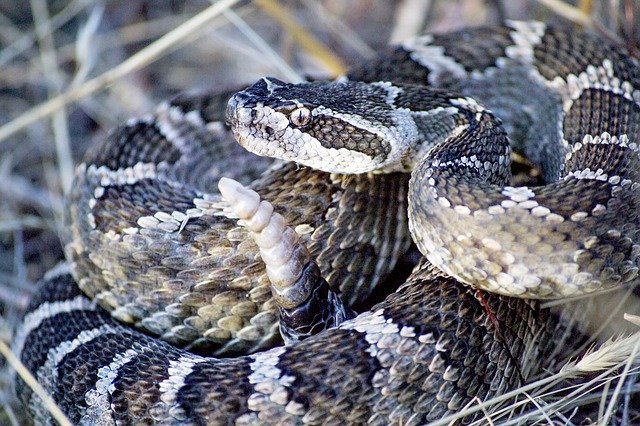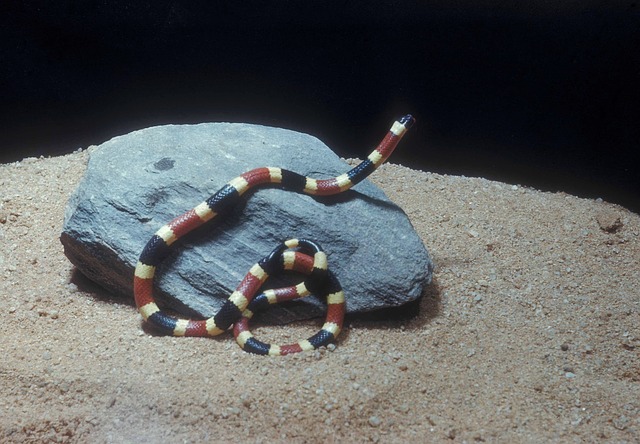Despite being tasty and readily available, snakes are often overlooked as a food source. Here’s what you need to know to hunt and eat snakes.
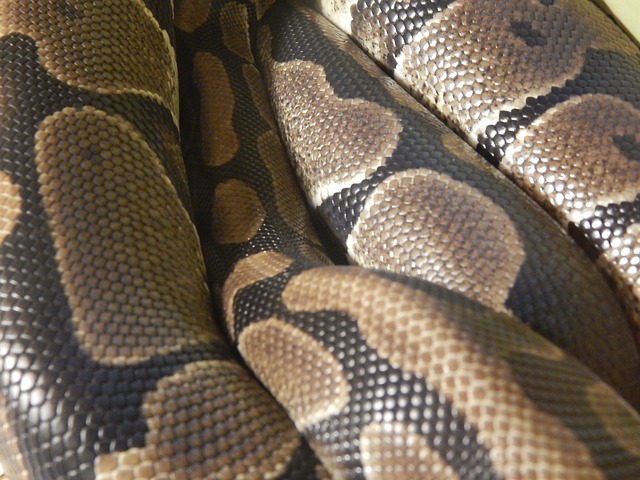
Image by Alejandra Acosta Brncich from Pixabay
How to Hunt and Eat Snakes
Most people who participate in hunting seek out various mammals, birds, and fish. However, there’s no reason why you can’t add snakes to this list!
Abundant in most areas of the United States and an excellent source of protein, most people who have tried snake meat report that it tastes just like chicken! Plus, you’ll get the added satisfaction of having obtained your dinner for yourself.
What do you think? Excited to try some ectotherms? This article will guide you through necessary equipment; how to identify kinds of snakes; and how to find, hunt, and cook them.
How to Hunt Snakes: Gear and Equipment
Generally, you’ll want to save your guns and rifles for hunting larger mammalian and avian prey. Most species of snakes are too small for this to be an effective method.
Instead, the safest method is to use a long stick with a small Y-shape at the end. The opening of the prongs of the Y should be large enough to trap a snake’s head, but not large enough that the snake can easily slither out of it.
You’ll also need a knife to cut off the head and clean the body of the animal, as well as cooking equipment that includes a fire starter. Hot sauce optional.
Identification of Snakes
We strongly advise you not attempt to hunt venomous snakes. While these animals are edible and even considered delicacies in places, the risks of hunting and killing them are too great to be worth the dangers involved.
This section will teach you how to identify which kinds of snakes are safe to hunt, and which you should steer clear from.
In the United States, there are four kinds of venomous snakes: copperheads, cottonmouths, rattlesnakes, and coral snakes.
Copperheads (as you may be able to guess from their name) have reddish-brown, copper colored heads. Their bodies are relatively thick, with hourglass-shaped markings that range from light brown to almost black. Copperheads can be found almost anywhere across the East Coast and Midwest United States.
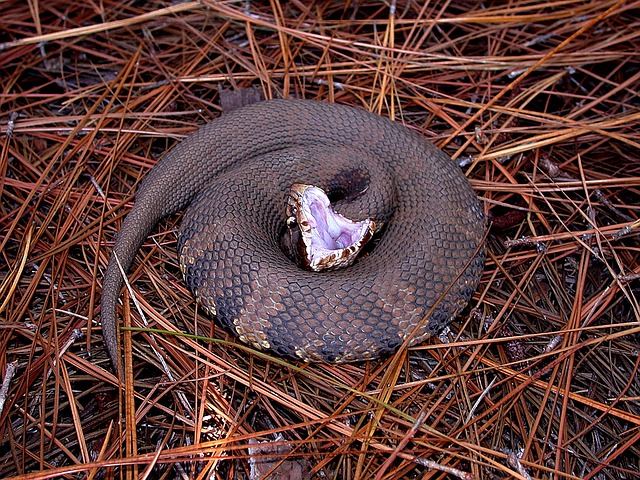
Cottonmouth/Water Moccasin; Image by Welcome to all and thank you for your visit ! ツ from Pixabay
Cottonmouths are sometimes called water moccasins, because they are semi-aquatic and are usually found in or near a body of water. They are often misidentified, being confused with harmless water snakes. The biggest tell is in the heads: cottonmouths have triangular, blocky heads with slender necks and thick bodies; water snakes’ heads blend into their bodies.
Rattlesnakes come in a large number of subspecies that differ in general appearance, habitat, and toxicity, but all can be identified by the distinctive rattles on the ends of their tails. You might hear a rattler before you see it—they shake their tails as a warning and when they feel threatened. Rattlesnakes are most often found in the South, Southwest, and Midwest.
Coral snakes are the only non-pit viper on this list. They are slender, with bright yellow, red, and black horizontal stripes. Often confused with the non-venomous scarlet snake, the two can be distinguished by the advice of a memorable rhyme: “red touching yellow kills a fellow; red touching black, safe for Jack.” They are mostly found in the Southeast and along the Gulf of Mexico.
How to Hunt Snakes: Method
If you are near paved roads, one of the most reliable ways to find snakes is by road cruising at dusk. Because reptiles are cold-blooded (meaning they can’t generate their own body heat and must moderate their temperature using outside sources), they can often be found laying on asphalt once the sun has gone down, because these surfaces retain heat from the day.
If there is no asphalt near you or you are hunting during the day, you are likely to find snakes slithering through tall grass, hiding under a rock or log, or basking on a rock.
You May Also Enjoy:
“How I Got a Venomous Snake Bite, Treated It at Home, and Lived to Tell the Tale”
When hunting, the most important thing to remember is to stay aware of your surroundings. You don’t want to be so focused on pursuing the animal that you find yourself unexpectedly in an unsafe situation.
As we mentioned above, you’ll use the Y-shaped end of the stick to pin the snake’s head to the ground. While it’s immobilized, quickly cut off the head with your knife. When aiming with your stick, make sure your reflexes are lightning-fast so that you strike accurately. Even non-venomous snakes can be dangerous if they whip their head back to bite you and the wound gets infected.
Try to accomplish this process quickly so that the snake does not suffer unnecessarily.
Once you’ve decapitated the snake, stay away from the head—this is not some kind of hunting trophy. They have been known to retain a bite reflex for up to an hour after death.
How to Cook Snakes
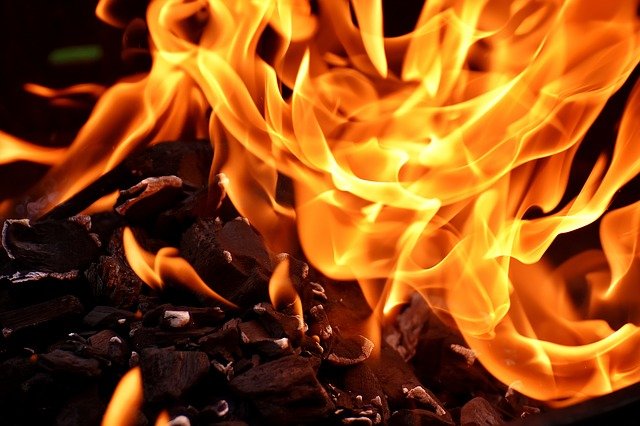
Image by Alexas_Fotos from Pixabay
One of the most important takeaways from this article should be that you must never eat raw snake meat.
Wild animals are breeding grounds for bacteria and parasites which can make you seriously sick if ingested. Especially with reptiles, there is risk of salmonella poisoning—this bacteria thrives in their digestive tracts.
Use your knife to clean the snake by making an incision at the neck and cutting down the length of its body. Remove the skin and all connective tissue.
You May Also Enjoy:
“8 Simple, Succulent Ways to Cook Duck (With Recipes)”
Then you’ll gut the snake. All of their innards are located in a tube which can be removed relatively cleanly—if you cut this tube, be prepared for it to get messy. Rinse what’s left of the carcass to remove any blood or intestine remaining.
After cleaning the snake, you’re ready to cook it. Cut it into about 6-inch pieces to make it more manageable to handle over a fire, and spear each on a stick. Hold the meat near the flame until it starts to turn brown, and then dig in!
After your meal, be sure to thoroughly clean your cooking equipment and dispose of any animal remains (bones, skin, etc.) far away from your campsite. This will discourage scavengers like bears, racoons, and foxes from coming near to enjoy your scraps.
Conclusion: How to Hunt and Eat Snakes
You don’t need any fancy gear or knowledge to hunt and eat snakes! Just the basics: a forked stick and knife and some basic info on identifying venomous snakes is enough to get started. Hunt safely and humanely, remember to cook your meal, and enjoy!
What Do You Think?
Have you hunted snakes before? What species have you eaten? Let us know in the comments below!
____________
The Grow Network is a participant in the Amazon Services LLC Associates Program, an affiliate program designed to provide a means for our team to earn fees for recommending our favorite products! We may earn a small commission, at no additional cost to you, should you purchase an item after clicking one of our links. Thanks for supporting TGN!

The Grow Network is a global network of people who produce their own food and medicine. We’re the coolest bunch of backyard researchers on Earth! We’re constantly sharing, discovering, and working together to test new paths for sustainable living—while reconnecting with the “old ways” that are slipping away in our modern world. We value soil, water, sunlight, simplicity, sustainability, usefulness, and freedom. We strive to produce, prepare, and preserve our own food and medicine, and we hope you do, too!
